EcoVillage Ithaca USA
Showing us the future
by Liz Walker
EcoVillage Ithaca (EVI) is developing an alternative model for suburban living, which provides a satisfying, healthy and socially rich lifestyle, while minimising ecological impacts. It is the largest, and one of the most well-known ecovillages in the U.S. EVI is recognized nationally and internationally for its pioneering work in developing a mainstream, green community with an exceptionally high quality of life, one that appeals to middleclass Americans, while cutting resource use by 60% or more.
We have a comprehensive approach to sustainability and we demonstrate best practices including: green building, densely clustered housing, low energy and water use, strong social ties, local food production, extensive waste reduction, affordability, accessibility, onsite businesses, open space preservation, and hands-on education. Our project is a grassroots development that has created a strong, participatory community.
Over 90% of the EVI land is preserved as open space for farming, wildlife habitat and recreational trails. The land includes meadows, woods, wetlands, streams and ponds. 20 ha (50 ac) of land have been set aside as a permanent conservation easement and are administered by the Finger Lakes Land Trust. There are three organic farms on the site, which together provide vegetables and fruit for 1,500 people in the greater Ithaca area. The 100 homes of the community are densely clustered on a footprint of just 3.64 ha (9 ac) of land, nestled within a total buffer zone of 6.07 ha (15 ac).
Learn@Ecovillage, the grassroots organization that founded the entire project, continues to work on the long-term vision, and educates the public. It is a project of the non-profit Center for Transformative Action, which is affiliated with Cornell University. Learn@EcoVillage works with students and researchers, often by utilising the ‘living laboratory’ of the village and small farms. It provides tours and immersion experiences to over 600 visitors annually. Recently we have been training architects, builders and engineers how to design and build Net Zero buildings, which produce more energy than they utilize year-round. Learn@EcoVillage also provides mentoring services and workshops for forming communities.
From vision to reality
In June 1991, Joan Bokaer and I organized an ‘Envisioning Retreat’ which brought together 100 people from around the US. This Envisioning Retreat discussed and adopted the basic concepts for EVI: a pedestrian village for up to 500 people, made up of cohousing communities, with lots of open space and organic farms, and ongoing educational opportunities. By the end of the five-day retreat people were very excited by the vision and a critical mass of people felt empowered to bring it to life.
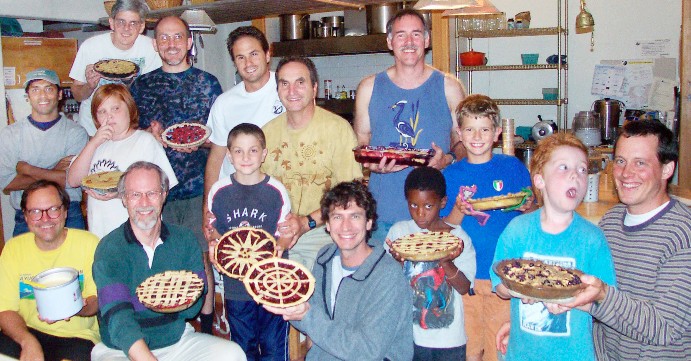
Annual ‘Guys Baking Pies’ celebration.
We began by securing land. After searching for developable parcels that included good farmland, we chose a 71.2 ha (176 ac) parcel that had been slated for a subdivision before the developer went bankrupt. The prior developer’s plan called for using 90% of the site for developing 150 homes, with just 10% open spacesubdivision. In our Envisioning Plan, 90% of the entire site is set aside for farms, woods, ponds and meadows, with just 10% used for 100 homes, common houses and parking.
Guidelines for development / site planning process
A committee created a comprehensive plan for long-term land use and development over the course of the first year after we purchased the land in 1992. We adopted a participatory strategy, with public forums that ranged from 60 people working together for an entire weekend, to a final session of just 12 people for an afternoon. The resulting Guidelines for Development have proven to be an important touchstone and set a high standard for both social and environmental sustainability. At the same time a proposed site plan was developed, using the same participatory methods. The final site plan clusters the three neighbourhoods in a triangle with a Village Green in the centre. The Village Green includes a picnic area, a small pond, a day-lighted stream, and beautiful southern views. It provides a large outdoor gathering space so the entire village can come together for events.
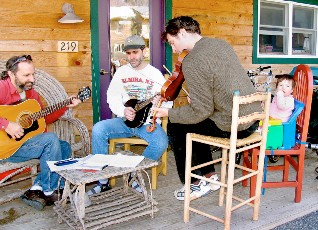
Porch musicians.
Farming at ecovillage
In 1992, Jen and John Bokaer-Smith started West Haven Farm, with a Community Supported Agriculture (CSA) which has now grown to 250 shareholders on 4.5 ha (11 ac). The farm currently feeds about 1,000 people a week during the growing season. The farm, which is certified organic, grows 250 varieties of vegetables, some fruits, flowers and herbs.
Another successful on-site farm is Kestel’s Perch Berries Farm, a no-pesticide, 2.2 ha (5 ac) U-Pick farm with six kinds of berries. This farm is also set up as a CSA, and attracts customers from around the area. Both farms lease land from the non-profit for the cost of the taxes paid on the land.
A third farm is a teaching farm for immigrants who want to create their own small farm businesses. Groundswell Center for Local Food and Farming, initiated by Learn@EcoVillage, now runs the on-site 3.2 ha (8 ac) Incubator Farm, but also teaches classes at many other local farms.
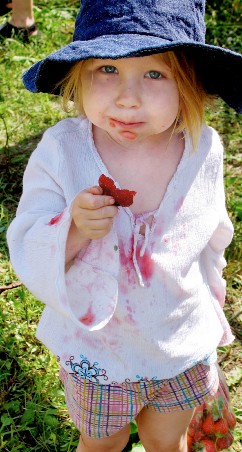
Catherine eating a strawberry.
First neighbourhood
Once the land was purchased, we started organising the First Resident Group, affectionately known as ‘FROG’, in the summer of 1992. The budding cohousing group spent four and a half years of intensive meetings to plan the neighbourhood, go through a gruelling town approval process, and build the thirty homes and 465 m2 (5,000 ft2) common house. The FROG common house is a community centre serving 30 households, with laundry, dining and kitchen facilities, play areas, living room, and eight ‘home’ offices. FROG home sizes are only 60% of typical US homes and consume 29% of the water and 60% of the energy, and their ecological footprint is 44% of the US average.
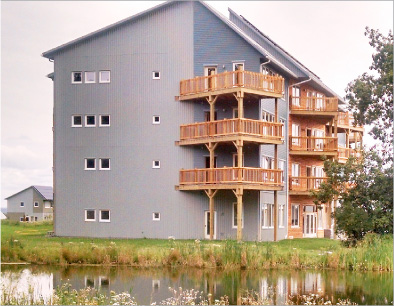
TREE Common House, with 15 apartments.
Mission
To promote experiential learning about ways of meeting human needs for shelter, food, energy, livelihood and social connectedness that are aligned with the long-term health and viability of Earth and all its inhabitants.
Second neighbourhood
In 2001 the first homes were built in SONG (Second Neighbourhood Group), in two phases: ‘SONG, Verse 1’, with 14 homes and ‘Verse 2’, with 16 homes, for a total of 30 homes by 2004. The common house was built in 2005-2006. Most homes were built using Structurally Insulated Panels, while some used timber-frame design with straw-bale insulation in the walls. SONG has an extensive free library, and a game room with ping-pong and pool tables for use by the Village.
Third neighbourhood
TREE (Third Residential Ecovillage Experience) decided to use the same kind of standardized design as FROG, thus lowering costs, and used some of the same charming, winding, European street design as FROG, while selecting a middle range of spacing between the houses compared to the other neighbourhoods. The TREE neighbourhood is one of the greenest neighbourhoods in the US, with all homes reaching the LEED Platinum standard, and some at Net Zero. In addition, the TREE neighbourhood won two awards from the US Department of Energy. The TREE Common House includes 15 apartments, many of which are rentals, allowing lower-income people to be residents.
Guidelines for development, green building, energy efficiency, and renewable energy
All homes are passive solar, superinsulated, and many have photovoltaic panels and solar hot water heating. Passivhaus home design used in TREE reduces energy use by 80-100% compared to typical US homes. The first neighbourhood has installed a 50 kW ground-mounted photovoltaic system, which provides 51% of the electricity for 30 homes. TREE also has a 50 kW solar array. Over half of SONG homes have rooftop solar panels.
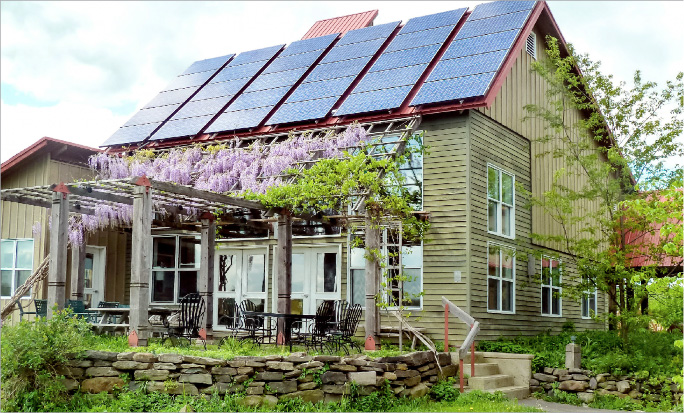
FROG Common House.
Densely clustered housing and open space preservation
EVI is a pedestrian village of three neighbourhoods—100 homes on a footprint of less than nine acres. More than 90% of the 71 ha (175 ac) site is set aside for natural areas, farming and wildlife habitat.
Modelling low resource use
There have been ecological footprint studies of EcoVillage Ithaca residents by graduate students from MIT and Cornell University. The latest study was by Jesse Sherry, from Rutgers University, who wrote his 2014 PhD dissertation on the topic. He found that overall, EVI residents reduced their ecological footprint by 64% compared to the US average, and that they used almost two-thirds fewer resources for food, transportation, energy and housing, than typical Americans.
Strong social ties
The three EVI neighbourhoods are based on ‘cohousing’, with shared common facilities and many shared social events, including several community meals a week. Residents love living at EVI. Many people describe it as an extended family—everyone knows everyone else.
Local food production
Two resident-owned farms supply organic fruits and vegetables to 1,500 county residents during the growing season. In addition, many residents grow their own food in community gardens.
On-site businesses
Almost half (45%) of wage-earning residents work or telecommute from home offices, or provide services for neighbours, lessening the need for commuting.

Extensive composting, recycling and re-use
Residents compost all non-meat kitchen scraps and have cut the need for garbage services by 75%.
Affordable, accessible
TREE was built as affordably as possible, while also putting planning for aging in place. Long-term affordability is enhanced by cutting utility bills to a minimum. One family with four children calculates that they have already saved $5,600 in the first three years of living in their extremely energy efficient TREE home, because their utility bills are so low.
Hands-on education
Learn@EcoVillage works with university students, budding cohousing groups, green building professionals, and anyone interested in learning more about sustainable communities. Our educational philosophy is to engage learners in hands-on practices, as well as to inspire them with a vision of ‘another world is possible’.
Public recognition & appeal
From its inception, EcoVillage at Ithaca has enjoyed great recognition as an integrated model of environmental and social sustainability.
It has received local, national and international awards, and has been consistently covered by major national and international media. This public appeal is based on how well these best practices work together to create a deeply satisfying way of life, one that speaks to the need for both social connection and connection with nature. At EVI we have found that the mere physical presence of a community that attempts to lead a life based on environmental and social values is inspiring to many people. There is a common ‘aha’ experience that one woman described well after a tour. She said: “You are showing us the future.”
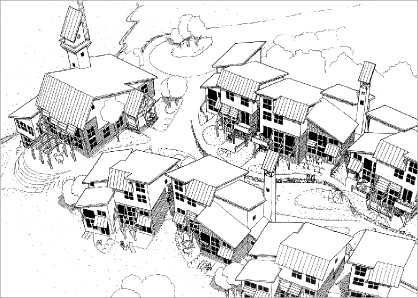
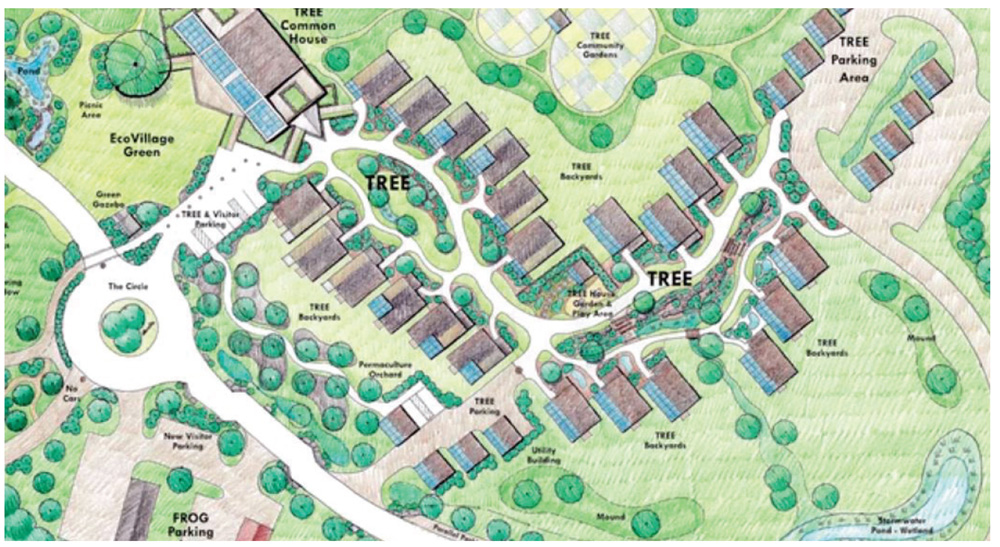
Location: Finger Lakes region, Ithaca, NY, USA.
Established: Planning 1991. Purchased land 1992.
Area: 70 ha (173 ac), of which 4 ha (10 ac) forest, 8.5 ha (21 ac) organic farms, 8000 m2 (86000 ft2) of community gardens, three ponds.
Population: 240 people, 75 children, 62 adults over 60. From 1 to 83 years old.
Housing: Three cohousing neighbourhoods, each with a Common House. FROG = First Resident Group, 15 duplexed townhouses (total of 30 homes). SONG =Second Neighbourhood Group, 15 duplexed townhouses (total of 30 homes). TREE = Third Residential Ecovillage Experience, 17 single family homes, 4 duplexes (8 homes), 15 apartments (total of 40 homes).
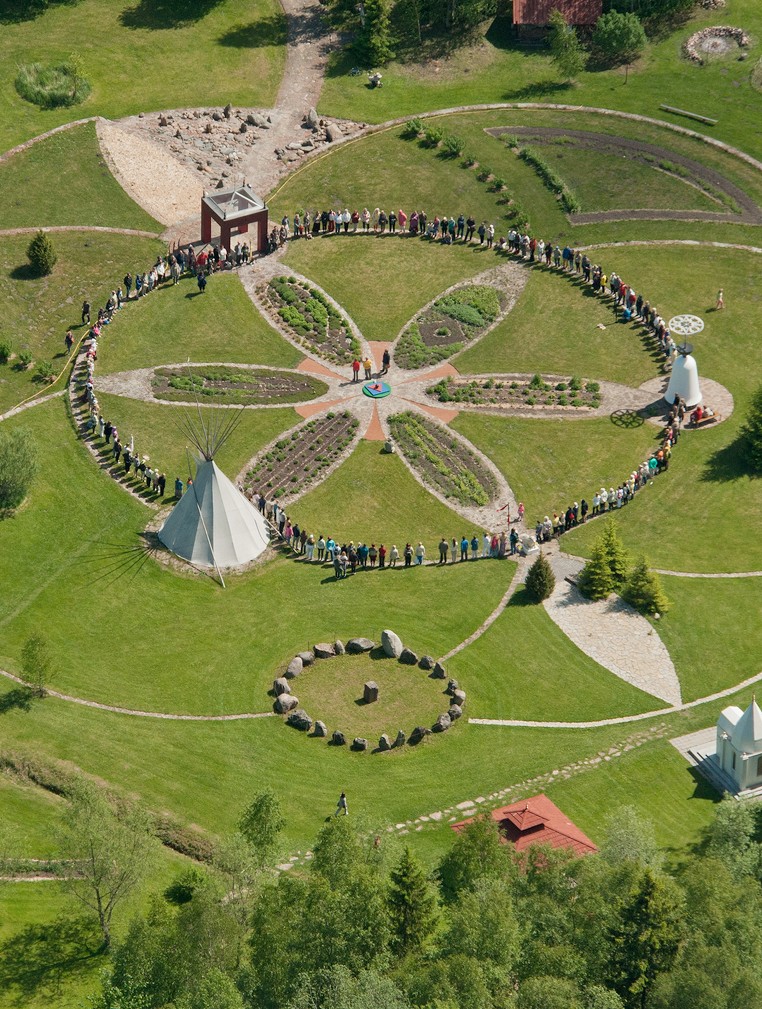
Flower of Life Park